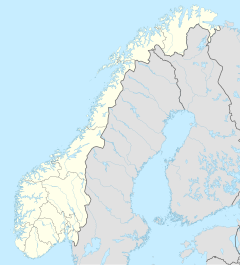Forollhogna National Park
| Forollhogna National Park | ||
|---|---|---|
|
|
||
| Location: | Innlandet , Trøndelag , Norway | |
| Next city: | Tynset , Røros , Støren | |
| Surface: | 1,062 km² | |
| Founding: | December 21, 2001 | |
| The national parks in southern Norway (The Forollhogna has number 13) | ||
| View from the summit of Forollhogna to the north | ||
| View of Forollhogna from Ilfjell | ||
The Forollhogna National Park ( Norwegian Forollhogna nasjonalpark or Forålhogna nasjonalpark ) is a 1,062 km² national park located in the provinces of Innlandet and Trøndelag between the Orkla , the E6 , the Gauldal and the Glomma .
The park was founded in 2001 as the 19th national park in Norway, the local large, contiguous and untouched mountain ranges, the landscape, biodiversity, with some rare and worth protecting creatures that mountain reindeer to protect and cultural heritage of the area.
The national park belongs to the municipalities of Tynset , Tolga and Os in the province of Innlandet and to Holtålen , Midtre Gauldal and Rennebu in Trøndelag. It also borders the Budalen , Vangrøftdalen-Kjurrudalen , Londalen-Ørvilldalen , Ledalen , Øyungen , Magnilldalen-Busjødalen , Endalen and Forddalen nature reserves , and the Grønntjønnan nature reserve is within the park . The eight nature reserves represent only an interim solution based on the conflict of maintaining and protecting nature and, on the other hand , using the land for agriculture .
Geography, landscape and geology
The landscape is characterized by small to medium-sized mountains , lakes and smaller rivers . Due to the fertile soil, there is a relatively large flora.
The highest point in the park is the Forollhogna at 1,332 m.
Flora and fauna
The most common landforms in the park are mountain birch forests , pasture and scrubland .
In addition to the scallop , golden eagles , gyrfalcons and hen harriers nest in the national park. Reindeer , elk , red deer , wolverines and arctic foxes are among the larger mammals in the park . In addition to numerous small rodents, the ptarmigan is also native to Forollhogna.
heritage Site
Traces of Sami settlement dating back a few millennia were found in the park , including remains of settlements, sacrificial sites and pitfalls .
The Pilgrimsleden leads to Nidaros (Østerdalsleden) through the Forollhogna. On the basis of archaeological finds along the way, it was possible to prove that this route was already an important traffic and trade route at the time when the area around the national park was settled. However, when the Røros copper mine started operating, the copper ore began to be transported over the mountains from Dalsbygda to Støren , which made the transport faster and easier.
Tourism and administration
There are information centers for the park in Kvikne , Dombås , Oppdal , Folldal , Otta and Sunndalsøra . Sometimes you can also get information about the national parks Dovrefjell-Sunndalsfjella , Rondane and Dovre .
There are numerous hiking trails and some mountain huts in Forollhogna National Park. Reindeer hunting is very popular around the national park and there are plenty of fishing opportunities, especially for trout . Furthermore, one comes across pastures with sheep and cattle again and again in summer . Adventure tourism with reindeer safaris, fishing, mountain tours, horse riding and sled dog tours is offered in several places around the national park.
See also
Web links
- Directorate for naturforvaltning: dirnat.no/forollhogna
- Forollhogna nasjonalpark - opplevelser i de snille fjell: forollhogna.no
literature
- Karl H. Brox , Per Jordhøy, Jon J. Meli. Opplev Forollhogna. Snøhetta forlag, Lesja 2006, ISBN 82-303-0728-8 .
- Nils Petter Vigerstøl, Johan Christian Frøstrup (eds.): Forollhogna. History, nature, culture. Friluftsforlaget, Arendal 2005, ISBN 82-91495-39-4 .
- Leif Ryvarden : Norges nasjonalparker. 2., opplag med revisjoner. Damm, Oslo 2005, ISBN 82-04-09324-1 .



